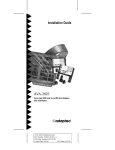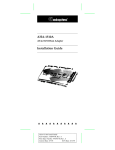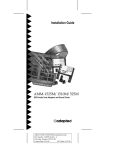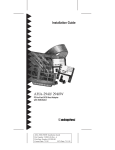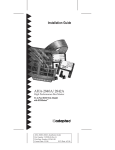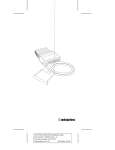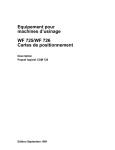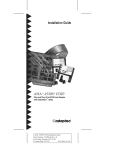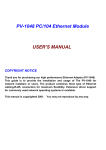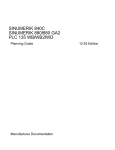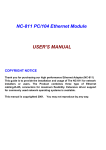Download AVA-1505 Installation Guide - Support
Transcript
R AVA-1505 AT-to-SCSI Host Adapter Installation Guide ▲ ▲ ▲ ▲ ▲ ▲ ▲ ▲ ▲ ▲ ▲ ▲ A AAAAAAAAAAAAAAAAAAAAAAAAAAAAAAAAAAAAAAAAAAAAAAAAAAAAAA AA A AA Document Title A AA A AA A AA Part Number: 510533-00, Rev. A A AA A AA A AA Print Spec Number: 492410-00 A AA A AA A Current Date: 1/24/94 ECN Date: 2/1/94 AA A AA AAAA A AAAA AAAA AAAA AAAA AAAA AAAA AAAA AAAA AAAA AAAA AAAA AAAA AAAAAAAAAAAAAAAAAAAAAAAAAAAAAAAAAAAAAAAAAAAAAAAAAAAAAA A AA 1 Getting Started This guide tells you how to install and configure the AVA™-1505 AT®-to-SCSI host adapter. Installation instructions are given in Sections 4 through 8. 2 Board Layout This figure identifies the major AVA-1505 components, and the table describes each component. 1 Location Description J11 J51 J61 F1 RN1, RN2, RN31 U3 Jumper Block 50-pin Internal SCSI Connector DB25 External SCSI Connector Fuse Terminators AIC-6360 PIO Chip Pin 1 is marked by 1 on the board. 3 Default Settings The AVA-1505 is designed to operate as shipped in most AT-class computers. The default settings are Parameter Default Setting SCSI Disconnection 1 SCSI Address 1 SCSI Parity 1 Terminators Terminator Power Interrupt Channel 2 AT Port Address 2 Enabled 7 Enabled Installed Supplied by host adapter 11 340h-35Fh 1 These 2 values are set by the software (see Section 6, Software Installation). See Section 8, Jumper Block Settings, to learn how to change these settings. 1 A AAAAAAAAAAAAAAAAAAAAAAAAAAAAAAAAAAAAAAAAAAAAAAAAAAAAAA AA A AA Document Title A AA A AA A AA Part Number: 510533-00, Rev. A A AA A AA A AA Print Spec Number: 492410-00 A AA A AA A Current Date: 1/24/94 ECN Date: 2/1/94 AA A AA AAAA A AAAA AAAA AAAA AAAA AAAA AAAA AAAA AAAA AAAA AAAA AAAA AAAA AAAAAAAAAAAAAAAAAAAAAAAAAAAAAAAAAAAAAAAAAAAAAAAAAAAAAA A AA 4 Installing the Host Adapter Setting Jumpers If you need to change jumper block settings, do it now before you replace the chassis cover. See Section 8, Jumper Block Settings, for details. In most cases, you do not have to change the default jumper settings. Here are situations in which you should change the settings: ■ If another Adaptec SCSI host adapter is already installed in your computer, you may need to change the interrupt channel of the AVA-1505. If you change the setting from the default of 11 (pin pair I11) you may also need to change options in the software (see Section 6, Software Installation). ■ If you change the default port address by installing the extra jumper on pin pair ALT, you may also need to change options in the software (see Section 6, Software Installation). Inserting the Board WARNING: Turn OFF and disconnect the power to your computer and attached devices before you remove the chassis cover. See your computer’s documentation for instructions on how to do this. 1 Remove the cover of your computer to expose the AT expansion slots. 2 Locate an unused AT expansion slot. AT-type slots have two edge connectors (one 62-pin and the other 34-pin) in line with each other. 3 Remove the expansion slot cover for this slot. 4 Align and insert the host adapter into the AT slot. Use the expansion slot cover screw to secure the host adapter to the frame. Note: Do not replace the chassis cover or reconnect the power yet! 2 A AAAAAAAAAAAAAAAAAAAAAAAAAAAAAAAAAAAAAAAAAAAAAAAAAAAAAA AA A AA Document Title A AA A AA A AA Part Number: 510533-00, Rev. A A AA A AA A AA Print Spec Number: 492410-00 A AA A AA A Current Date: 1/24/94 ECN Date: 2/1/94 AA A AA AAAA A AAAA AAAA AAAA AAAA AAAA AAAA AAAA AAAA AAAA AAAA AAAA AAAA AAAAAAAAAAAAAAAAAAAAAAAAAAAAAAAAAAAAAAAAAAAAAAAAAAAAAA A AA 5 Connecting Peripherals Setting SCSI IDs You must assign a different SCSI ID to each device on the AVA-1505 SCSI bus. See your SCSI peripheral documentation for directions on how to determine the ID and change it. The default SCSI ID for AVA-1505 host adapters is SCSI ID 7. Connecting Cables SCSI devices are cabled together in a single, connected series called the SCSI bus. The SCSI bus cables must run sequentially from one device to the next. The host adapter is at the end of the SCSI bus if either the internal or the external SCSI connector is unused. The host adapter is in the middle of the bus if internal and external SCSI devices are installed. Caution: AVA-1505 host adapters support only single-ended SCSI devices. Differential SCSI devices may be damaged if connected to the host adapter. The peripheral documentation will tell you whether the device is single-ended or differential. 1 Lay out the cables and find the pin-1 element of each cable and peripheral connector. On internal cables, pin 1 is usually marked with a contrasting color on one edge of the ribbon cable, and a small triangle marks pin 1 on the SCSI connector. External cable connectors can only be plugged-in one way, so pin-1 orientation is automatic. 2 Attach the SCSI cable(s) to the host adapter and the peripheral(s), using the internal and/or external connector(s). 3 Be sure to maintain correct pin-1 orientation throughout the bus. The AVA-1505 uses a 25-pin DB25 external connector (Apple compatible), and a 50-pin flat ribbon-type internal connector. Terminating the SCSI Bus Cable The last physical SCSI device on either end of the SCSI bus must have a set of resistors called termina3 A AAAAAAAAAAAAAAAAAAAAAAAAAAAAAAAAAAAAAAAAAAAAAAAAAAAAAA AA A AA Document Title A AA A AA A AA Part Number: 510533-00, Rev. A A AA A AA A AA Print Spec Number: 492410-00 A AA A AA A Current Date: 1/24/94 ECN Date: 2/1/94 AA A AA AAAA A AAAA AAAA AAAA AAAA AAAA AAAA AAAA AAAA AAAA AAAA AAAA AAAA AAAAAAAAAAAAAAAAAAAAAAAAAAAAAAAAAAAAAAAAAAAAAAAAAAAAAA A AA tors. Terminators must be removed from, or disabled on, all other devices on the SCSI bus. The AVA-1505 and most SCSI peripherals have builtin terminators that can be enabled or disabled. Terminate only the devices at each end of the SCSI bus. Terminating the Host Adapter The three factory-installed terminators on the AVA-1505 host adapter are located below the internal SCSI connector, as shown in the diagram on page 1. You must remove these terminators if you attach SCSI devices to both the internal and external SCSI connectors, since the host adapter is then in the middle of the SCSI bus. Terminators are 8-pin 220/330 ohms resistors. The table below shows how termination should be set for the three possible SCSI device and host adapter configurations. Devices Connected to Host Adapter Internal devices only (host adapter at end of bus) External devices only (host adapter at end of bus) Internal and external devices (host adapter in the middle of the bus) AVA-1505 Terminators All three installed All three installed All three removed Terminating SCSI Peripherals 1 Check the manufacturer’s documentation to determine how to enable or disable SCSI bus termination on your SCSI peripheral device(s). 2 Install/enable terminators on SCSI devices at the ends of the SCSI bus (cable). 3 Remove/disable terminators on all other devices on the SCSI bus. 4 Be sure the SCSI cables are connected securely. They may have been loosened if you changed jumpers settings on the peripherals. Reassembling and Starting the System 1 Replace the computer chassis cover, following the instructions in your computer’s documentation. 2 Turn all power switches OFF, then reconnect power cables to your computer. 4 A AAAAAAAAAAAAAAAAAAAAAAAAAAAAAAAAAAAAAAAAAAAAAAAAAAAAAA AA A AA Document Title A AA A AA A AA Part Number: 510533-00, Rev. A A AA A AA A AA Print Spec Number: 492410-00 A AA A AA A Current Date: 1/24/94 ECN Date: 2/1/94 AA A AA AAAA A AAAA AAAA AAAA AAAA AAAA AAAA AAAA AAAA AAAA AAAA AAAA AAAA AAAAAAAAAAAAAAAAAAAAAAAAAAAAAAAAAAAAAAAAAAAAAAAAAAAAAA A AA 3 Turn ON the power for the peripheral(s) then for the computer. In most cases your computer, host adapter, and SCSI peripherals are now ready to use. Booting the Computer The AVA-1505 does not provide booting capability. If you want to boot from a SCSI drive installed on the host adapter, you can install an AVA-1515, which provides booting capability. 6 Software Installation DOS/Windows Platforms For installing software, insert the software diskette into a floppy diskette drive, change to the drive letter of that drive (either A or B), and type install and press Enter. Then follow the instructions onscreen or in the software documentation. Remember the software and hardware settings for interrupt channel and port address must match, see Section 4, Installing the Host Adapter, and Section 8, Jumper Block Settings. Note: If you change the interrupt channel or the port address jumper setting after installing the software, you may need to reinstall or reconfigure the software. See the software documentation. 7 Troubleshooting Checklist If you have a problem during installation, check these items first: ■ Are all SCSI peripheral devices powered? Did you power them before system boot? ■ Are all SCSI bus cables and power cables properly connected? ■ Do the host adapter and all devices on the SCSI bus have unique SCSI IDs? ■ Are all devices on the SCSI bus terminated properly? (See Section 5, Connecting Peripherals.) 5 A AAAAAAAAAAAAAAAAAAAAAAAAAAAAAAAAAAAAAAAAAAAAAAAAAAAAAA AA A AA Document Title A AA A AA A AA Part Number: 510533-00, Rev. A A AA A AA A AA Print Spec Number: 492410-00 A AA A AA A Current Date: 1/24/94 ECN Date: 2/1/94 AA A AA AAAA A AAAA AAAA AAAA AAAA AAAA AAAA AAAA AAAA AAAA AAAA AAAA AAAA AAAAAAAAAAAAAAAAAAAAAAAAAAAAAAAAAAAAAAAAAAAAAAAAAAAAAA A AA ■ Do your SCSI devices support parity checking? ■ Is the fuse (F1) discolored? ■ If your system has multiple host adapters, did you assign each host adapter a unique interrupt channel and port address? If you need replacement components such as a fuse, jumper shunt, or terminator, see your dealer. 8 Jumper Block Settings The AVA-1505 jumper block settings are silkscreened on the board and are used to configure user-selectable options. In the diagram on page 1, the black bar covering both pins represents an installed jumper. This table below shows all the possible settings for the two jumpers on Jumper block J1. Default settings are marked with an asterisk (*). Pin Pair1 I09 I10 I11 I12 ALT2 On Off Interrupt Channel 093 10 11* 12 PIO Port Address 140h-15Fh 340h-35Fh* On = Jumper Off = No Jumper 1 Place jumper on only one interrupt channel pin pair. An extra jumper is provided if you want to change the port address. 3 Not recommended with Windows 3.x. 2 9 Adaptec Customer Support ■ For information on upgrades, utility programs, and technical advice, call Adaptec’s Electronic Bulletin Board Service 24 hours a day at 408-945-7727. 1200, 2400, 9600, or 14400 baud, using 8 data bits, 1 stop bit, no parity. ■ For the latest online information about Adaptec products and services, call the Interactive Fax Service 23 hours a day at 408-957-7150. ■ For technical assistance, call Adaptec’s Technical Support Hot Line at 800-959-SCSI (7274), or 408-945-2550. M–Th: 6:00a.m.–5:00p.m., F: 6:00a.m.–3:00p.m., Pacific Time. ■ To order Adaptec software, call 800-442-SCSI (7274) or 818-365-6264. M–F: 5:00a.m.–6:00p.m., Pacific Time. ■ To request literature on Adaptec products, call 800-934-2766. M–F: 5:00a.m.–6:00p.m., Pacific Time. 6 A AAAAAAAAAAAAAAAAAAAAAAAAAAAAAAAAAAAAAAAAAAAAAAAAAAAAAA AA A AA Document Title A AA A AA A AA Part Number: 510533-00, Rev. A A AA A AA A AA Print Spec Number: 492410-00 A AA A AA A Current Date: 1/24/94 ECN Date: 2/1/94 AA A AA AAAA A AAAA AAAA AAAA AAAA AAAA AAAA AAAA AAAA AAAA AAAA AAAA AAAA AAAAAAAAAAAAAAAAAAAAAAAAAAAAAAAAAAAAAAAAAAAAAAAAAAAAAA A AA FCC Compliance Statement NOTE: This equipment has been tested and found to comply with the limits for a Class B digital device, pursuant to Part 15 of the FCC rules. These limits are designed to provide reasonable protection against harmful interference in residential installations. This equipment generates, uses, and can radiate radio frequency energy, and if not installed and used in accordance with the instructions, may cause harmful interference to radio communications. However, there is no guarantee that interference will not occur in a particular installation. If this equipment does cause interference to radio or television equipment reception, which can be determined by turning the equipment off and on, the user is encouraged to try to correct the interference by one or more of the following measures: • • • Reorient or relocate the receiving antenna Move the equipment away from the receiver Plug the equipment into an outlet on a circuit different from that to which the receiver is powered • If necessary, the user should consult the dealer or an experienced radio/ television technician for additional suggestions CAUTION: Only equipment certified to comply with Class B (computer input/output devices, terminals, printers, etc.) should be attached to this equipment, and must have shielded interface cables. Finally, any change or modifications to the equipment by the user not expressly approved by the grantee or manufacturer could void the user's authority to operate such equipment. Each AVA-1505 is equipped with an FCC compliance label which shows only the FCC Identification number. The full text of the associated label follows: This device complies with part 15 of the FCC rules. Operation is subject to the following two conditions: (1) this device may not cause harmful interference and (2) this device must accept any interference received, including interference that may cause undesired operation. Adaptec, Inc. 691 South Milpitas Blvd. Milpitas, California 95035 Copyright © 1994, Adaptec, Inc. All rights reserved. Adaptec and the Adaptec logo are registered trademarks, and AVA is a trademark of Adaptec, Inc. AT is a registered trademark of International Business Machines Corporation. Printed in Singapore Stock No.: 510533-00, Rev. A CV 1/94 Information subject to change without notice. 7 A AAAAAAAAAAAAAAAAAAAAAAAAAAAAAAAAAAAAAAAAAAAAAAAAAAAAAA AA A AA Document Title A AA A AA A AA Part Number: 510533-00, Rev. A A AA A AA A AA Print Spec Number: 492410-00 A AA A AA A Current Date: 1/24/94 ECN Date: 2/1/94 AA A AA AAAA A AAAA AAAA AAAA AAAA AAAA AAAA AAAA AAAA AAAA AAAA AAAA AAAA AAAAAAAAAAAAAAAAAAAAAAAAAAAAAAAAAAAAAAAAAAAAAAAAAAAAAA A AA








